How to create a financial forecast for a locksmith company?
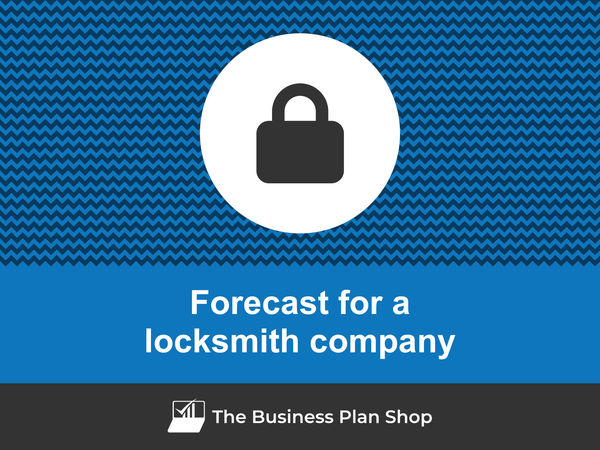
Developing and maintaining an up-to-date financial forecast for your locksmith company is key in order to maintain visibility on your business’s future cash flows.
If you feel overwhelmed at the thought of putting together a locksmith company financial forecast then don’t worry as this guide is here to help you.
We'll cover everything from: the main objectives of a financial forecast, the data you need to gather before starting, to the tables that compose it, and the tools that will help you create and maintain your forecast efficiently.
Let's get started!
Why create and maintain a financial forecast for a locksmith company?
Creating and maintaining an up-to-date financial forecast is the only way to steer the development of your locksmith company and ensure that it can be financially viable in the years to come.
A financial plan for a locksmith company enables you to look at your business in detail - from income to operating costs and investments - to evaluate its expected profitability and future cash flows.
This gives you the visibility needed to plan future investments and expansion with confidence.
And, when your trading environment gets tougher, having an up to date locksmith company forecast enables you to detect potential upcoming financing shortfalls in advance, enabling you to make adjustments or secure financing before you run out of cash.
It’s also important to remember that your locksmith company's financial forecast will be essential when looking for financing. You can be 100% certain that banks and investors will ask to see your numbers, so make sure they’re set out accurately and attractively.
Need a solid financial forecast?
The Business Plan Shop does the maths for you. Simply enter your revenues, costs and investments. Click save and our online tool builds a three-way forecast for you instantly.

What information is needed to build a locksmith company financial forecast?
The quality of your inputs is key when it comes to financial modelling: no matter how good the model is, if your inputs are off, so will the forecast.
If you are building a financial plan to start a locksmith company, you will need to have done your market research and have a clear picture of your sales and marketing strategies so that you can project revenues with confidence.
You will also need to have a clear idea of what resources will be required to operate the locksmith company on a daily basis, and to have done your research with regard to the equipment needed to launch your venture (see further down this guide).
If you are creating a financial forecast of an existing locksmith company, things are usually simpler as you will be able to use your historical accounting data as a budgeting base, and complement that with your team’s view on what lies ahead for the years to come.
Let's now zoom in on what will go in your locksmith company's financial forecast.
The sales forecast for a locksmith company
From experience, it is usually best to start creating your locksmith company financial forecast by your sales forecast.
To create an accurate sales forecast for your locksmith company, you will have to rely on the data collected in your market research, or if you're running an existing locksmith company, the historical data of the business, to estimate two key variables:
- The average price
- The number of monthly transactions
To get there, you will need to consider the following factors:
- Demand for locksmith services: As the demand for locksmith services increases, you can expect to see an increase in the average price of your services. This is because customers are willing to pay a higher price for urgent or emergency services, such as being locked out of their homes or cars.
- Competition: If there is high competition in your area, you may need to lower your prices in order to remain competitive. This can affect your average price and number of monthly transactions, as customers are more likely to choose a lower-priced locksmith over a higher-priced one.
- Seasonal demand: Locksmith services may be in higher demand during certain seasons, such as winter when people are more likely to get locked out of their cars due to cold weather. This can result in higher average prices and increased monthly transactions during these periods.
- Technological advancements: As technology continues to advance, you may need to invest in new equipment or tools in order to keep up with the latest security systems. This can impact your average price, as you may need to charge more for services that require specialized equipment.
- Economic conditions: Economic conditions, such as a recession or a boom, can affect your average price and number of monthly transactions. During a recession, customers may be more price sensitive and may opt for lower-priced locksmith services or delay non-urgent services, resulting in a decrease in average price and monthly transactions.
Once you have an idea of what your future sales will look like, it will be time to work on your overhead budget. Let’s see what this entails.
Need inspiration for your business plan?
The Business Plan Shop has dozens of business plan templates that you can use to get a clear idea of what a complete business plan looks like.

The operating expenses for a locksmith company
The next step is to estimate the expenses needed to run your locksmith company on a day-to-day basis.
These will vary based on the level of sales expected, and the location and size of your business.
But your locksmith company's operating expenses should include the following items at a minimum:
- Staff Costs: This includes the salaries and wages of your locksmiths, office staff, and any other employees you may have.
- Accountancy Fees: You will need to hire an accountant to help you manage your finances, file taxes, and keep track of your company's expenses.
- Insurance Costs: As a locksmith company, you will need to have insurance to protect your business from any potential risks or liabilities.
- Software Licences: You may need to purchase software licenses for your accounting, inventory management, and customer relationship management (CRM) systems.
- Banking Fees: This includes fees for maintaining a business bank account, processing credit card payments, and any other banking services you may need.
- Vehicle Expenses: If you have company vehicles for your locksmiths, you will need to budget for gas, maintenance, and insurance costs.
- Office Rent: This includes the cost of renting or leasing a physical office space to run your business.
- Marketing and Advertising: You may need to allocate funds for marketing and advertising efforts to promote your locksmith services and attract new customers.
- Inventory and Supplies: As a locksmith company, you will need to purchase supplies such as locks, keys, and other equipment to perform your services.
- Training and Development: It's important to invest in the ongoing training and development of your locksmiths to keep their skills and knowledge up-to-date.
- Utilities: This includes the cost of electricity, water, and other utilities for your office space and any company-owned vehicles.
- Legal Fees: You may need to hire a lawyer for legal advice and assistance with contracts, permits, and any other legal matters related to your business.
- Office Supplies: This includes the cost of purchasing office supplies such as paper, pens, and other stationery items.
- Telephone and Internet: You will need to budget for the cost of phone and internet services for your office and any company-owned devices.
- Professional Memberships: As a locksmith company, you may want to join professional organizations or associations for networking and educational purposes.
This list is, of course, not exhaustive, and you'll have to adapt it according to your precise business model and size. A small locksmith company might not have the same level of expenditure as a larger one, for example.
What investments are needed to start or grow a locksmith company?
Your locksmith company financial forecast will also need to include the capital expenditures (aka investments in plain English) and initial working capital items required for the creation or development of your business.
For a locksmith company, these could include:
- Locksmith Tools and Equipment: As a locksmith company, you will need to invest in high-quality tools and equipment to provide quality services to your clients. This can include items such as lockpicks, key cutting machines, key duplicators, and lock rekeying kits.
- Vehicle Fleet: Your locksmith company will require reliable transportation to reach clients and provide on-site services. You may need to purchase or lease vehicles such as vans or trucks to carry your tools and equipment to different locations.
- Security Systems: It is essential to ensure the security of your office and workshop, as well as your clients' properties. Investing in security systems such as CCTV cameras, alarm systems, and access control systems can help protect your assets and give peace of mind to your clients.
- Workshop and Office Space: To run your locksmith business efficiently, you will need a dedicated workspace for key cutting, lock repairs, and administrative tasks. This may involve renting or purchasing a commercial space and outfitting it with necessary equipment and furniture.
- Computer Systems and Software: As technology plays a significant role in the locksmith industry, you may need to invest in computers, laptops, and software to manage your business operations and communicate with clients. This can include accounting software, scheduling software, and inventory management systems.
Again, this list will need to be adjusted according to the size and ambitions of your locksmith company.
Need a convincing business plan?
The Business Plan Shop makes it easy to create a financial forecast to assess the potential profitability of your projects, and write a business plan that’ll wow investors.

The financing plan of your locksmith company
The next step in the creation of your financial forecast for your locksmith company is to think about how you might finance your business.
You will have to assess how much capital will come from shareholders (equity) and how much can be secured through banks.
Bank loans will have to be modelled so that you can separate the interest expenses from the repayments of principal, and include all this data in your forecast.
Issuing share capital and obtaining a bank loan are two of the most common ways that entrepreneurs finance their businesses.
What tables compose the financial plan for a locksmith company?
Now let's have a look at the main output tables of your locksmith company's financial forecast.
The profit & loss forecast
The forecasted profit & loss statement will enable you to visualise your locksmith company's expected growth and profitability over the next three to five years.
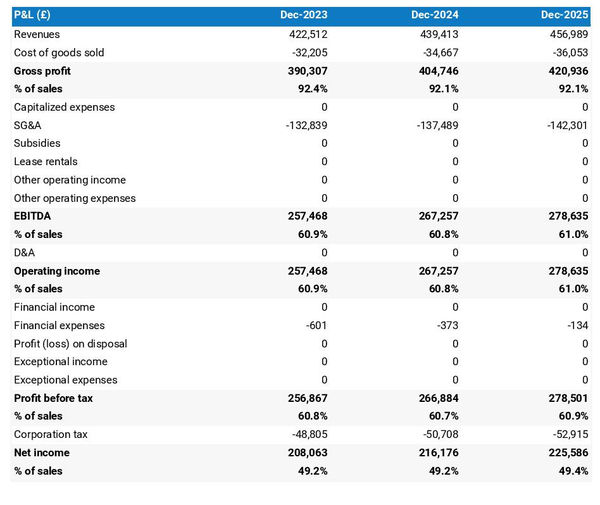
A financially viable P&L statement for a locksmith company should normally show:
- Sales growing above inflation
- Stable or expanding (ideally) profit margins
- A net profit
This will of course depend on the stage of your business: a new venture might be loss-making until it reaches its breakeven point in year 2 or 3, for example.
The projected balance sheet
Your locksmith company's projected balance sheet provides a snapshot of your business’s financial position at year-end.
It is composed of three types of elements: assets, liabilities and equity:
- Assets: represent what the business possesses including cash, equipment, and accounts receivable (money owed by clients).
- Liabilities: represent funds advanced to the business by lenders and other creditors. They include accounts payable (money owed to suppliers), taxes payable and loans from banks and financial institutions.
- Equity: is the combination of what has been invested by the business owners and the cumulative profits and losses generated by the business to date (which are called retained earnings). Equity is a proxy for the value of the owner's stake in the business.
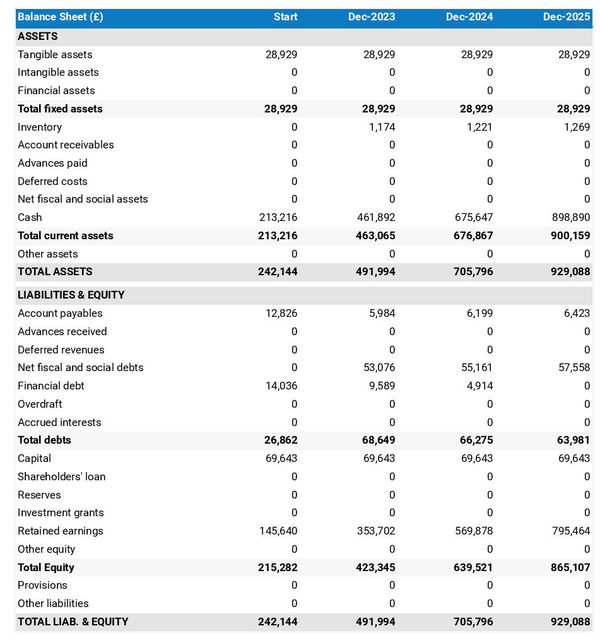
The projected cash flow statement
A projected cash flow statement for a locksmith company is used to show how much cash the business is generating or consuming.
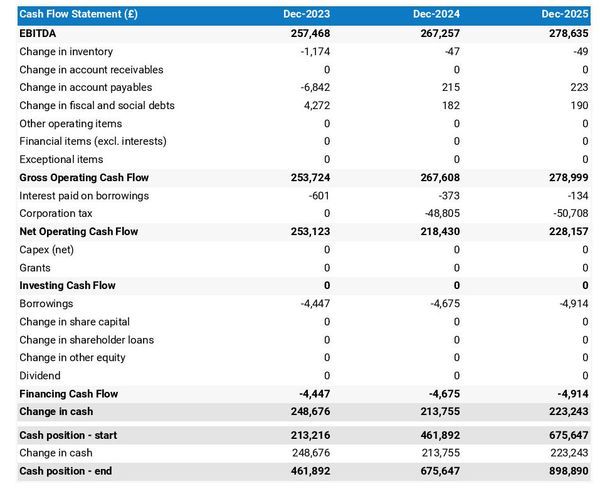
The cash flow forecast is usually organised by nature to show three key metrics:
- The operating cash flow: do the core business activities generate or consume cash?
- The investing cash flow: how much is the business investing in long-term assets (this is usually compared to the level of fixed assets on the balance sheet to assess whether the business is regularly maintaining and renewing its equipment)?
- The financing cash flow: is the business raising new financing or repaying financiers (debt repayment, dividends)?
Cash is king and keeping an eye on future cash flows is imperative for running a successful business. Therefore, you should pay close attention to your locksmith company's cash flow forecast.
If you are trying to secure financing, note that it is customary to provide both yearly and monthly cash flow forecasts in a financial plan - so that the reader can analyze seasonal variation and ensure the locksmith company is appropriately capitalised.
Need a solid financial forecast?
The Business Plan Shop does the maths for you. Simply enter your revenues, costs and investments. Click save and our online tool builds a three-way forecast for you instantly.

Which tool should you use to create your locksmith company's financial forecast?
Using the right tool or solution will make the creation of your locksmith company's financial forecast much easier than it sounds. Let’s explore the main options.
Using online financial forecasting software to build your locksmith company's projections
The modern and easiest way is to use professional online financial forecasting software such as the one we offer at The Business Plan Shop.
There are several advantages to using specialised software:
- You can easily create your financial forecast by letting the software take care of the financial calculations for you without errors
- You have access to complete financial forecast templates
- You get a complete financial forecast ready to be sent to your bank or investors
- You can easily track your actual financial performance against your financial forecast, and recalibrate your forecast as the year goes by
- You can create scenarios to stress test your forecast's main assumptions
- You can easily update your forecast as time goes by to maintain visibility on future cash flows
- You have a friendly support team on standby to assist you when you are stuck
- It’s cost-efficient and much cheaper than using an accountant or consultant (see below)
If you are interested in this type of solution, you can try our forecasting software for free by signing up here.
Hiring a financial consultant or chartered accountant
Hiring a consultant or chartered accountant is also an efficient way to get a professional locksmith company financial projection.
As you can imagine, this solution is much more expensive than using software. From experience, the creation of a simple financial forecast over three years (including a balance sheet, income statement, and cash flow statement) is likely to start around £700 or $1,000 excluding taxes.
The indicative estimate above, is for a small business, and a forecast done as a one-off. Using a financial consultant or accountant to track your actuals vs. forecast and to keep your financial forecast up to date on a monthly or quarterly basis will naturally cost a lot more.
If you choose this solution, make sure your service provider has first-hand experience in your industry, so that they may challenge your assumptions and offer insights (as opposed to just taking your figures at face value to create the forecast’s financial statements).
Why not use a spreadsheet such as Excel or Google Sheets to build your locksmith company's financial forecast?
Creating an accurate and error-free locksmith company financial forecast on Excel (or any spreadsheet) is very technical and requires both a strong grasp of accounting principles and solid skills in financial modelling.
Most entrepreneurs lack the expertise required to create an accurate financial forecast using spreadsheet software like Excel or Google Sheets. As a result, it is unlikely anyone will trust your numbers.
The second reason is that it is inefficient. Building forecasts on spreadsheets was the only option in the 1990s and early 2000s, nowadays technology has advanced and software can do it much faster and much more accurately.
This is why professional forecasters all use software. With the rise of AI, software is also becoming smarter at helping us detect mistakes in our forecasts and helping us analyse the numbers to make better decisions.
Finally, like everything with spreadsheets, tracking actuals vs. forecasts and updating your forecast as the year progresses is manual, tedious, error-prone, and time-consuming. Whereas financial forecasting software like The Business Plan Shop is built for this.
Need a convincing business plan?
The Business Plan Shop makes it easy to create a financial forecast to assess the potential profitability of your projects, and write a business plan that’ll wow investors.

Use our financial projection templates for inspiration
The Business Plan Shop has dozens of financial forecasting templates available.
Our examples contain both the financial forecast, and a written business plan which presents, in detail, the company, the team, the strategy, and the medium-term objectives.
Whether you are just starting out or already have your own locksmith company, looking at our template is always a good way to get ideas on how to model financial items and what to write when creating a business plan to secure funding.
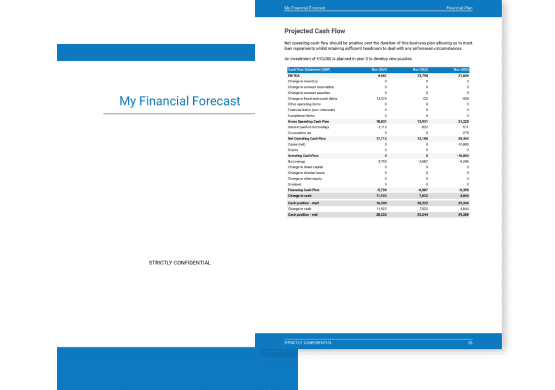
Takeaways
- A financial projection shows expected growth, profitability, and cash generation for your business over the next three to five years.
- Tracking actuals vs. forecast and keeping your financial forecast up-to-date is the only way to maintain visibility on future cash flows.
- Using financial forecasting software makes it easy to create and maintain up-to-date projections for your locksmith company.
You have reached the end of our guide. We hope you now have a better understanding of how to create a financial forecast for a locksmith company. Don't hesitate to contact our team if you have any questions or want to share your experience building forecasts!
Need inspiration for your business plan?
The Business Plan Shop has dozens of business plan templates that you can use to get a clear idea of what a complete business plan looks like.

Also on The Business Plan Shop
Know someone who runs or wants to start a locksmith company? Share our financial projection guide with them!




